George Ferguson (colonial administrator) facts for kids
George Ferguson (1748 – 29 December 1820) was an important person from Scotland. He was the fourth Laird (or owner) of the large Pitfour estate in Aberdeenshire. This estate was so grand it was sometimes called "The Blenheim of the North."
George Ferguson spent a lot of his life in Tobago, an island in the Caribbean. He became the lieutenant governor there in 1779. In 1781, he had to surrender the island to the French after a battle. Some people thought he gave up too easily, but an official investigation later cleared him of any wrongdoing. People often called him "the Governor" to tell him apart from other family members named George Ferguson.
He was only the Laird of Pitfour for about three months. After his death, his large estate, which included plantations in the Caribbean, went to his son.
Contents
Early Life and Family
George Ferguson was born in 1748 at Pitfour, in the north-east of Scotland. His father was James Ferguson, Lord Pitfour, who became a judge in 1764. His mother was Anne Murray. She was the sister of two important people: Patrick Murray, 5th Lord Elibank and James Murray, who was a British Army officer and governor of Quebec.
George had two older brothers. The oldest, James (1736–1820), became a politician and the third Laird of Pitfour. His other brother, Patrick (1744–1780), was an inventor. He created the Ferguson rifle, a special type of gun. George also had three sisters named Ann, Elizabeth, and Jane.
As a child, George was not very strong. His sister once described him as "tender" but having "more genius than application." She also said he had "a heart as warm and honest as you could wish." His brother Patrick sometimes jokingly called him "little man monster."
Life in Tobago
In 1770, George's older brother Patrick bought a large property called Castara estate in Tobago. George went to Tobago in the early 1770s to help manage this estate for his brother.
He worked hard and made the estate very successful. They sent products like rum, sugar, and molasses back to the UK. In 1778, George bought land in Tobago for himself. After his brother Patrick died, George inherited the Castara estate. This made him one of the biggest landowners on the island. The sugar plantations brought in a lot of money, and many people worked there.
In 1779, when George was in his early thirties, he was made the Lieutenant Governor of Tobago. He was usually called "the Governor" to avoid confusion with other family members.
Britain had taken control of Tobago in 1762, and this was confirmed after the Seven Years' War in 1763. However, on 23 May 1781, a French fleet arrived to try and take the island back. The French landed 3,000 soldiers near Plymouth. Governor Ferguson and his troops fought bravely. He held out until the French started burning the sugar plantations. He eventually surrendered on 2 June 1781.
After the surrender, Governor Ferguson returned to Britain. The British fleet commander, Admiral Rodney, accused Ferguson and his troops of surrendering too easily. However, Ferguson strongly denied these claims. An official investigation looked into the Governor's actions during the battle. In June 1783, the investigation cleared him of any blame.
Later Life in Britain
Even though Governor Ferguson returned to Britain, the terms of the surrender allowed him to keep all his property in Tobago. This included his plantations and the people working on them.
For a short time around October 1781, the Governor lived in Jermyn Street, London. He sent a letter to The London Gazette to strongly deny Admiral Rodney's accusations. Later, he lived with his older brother James at 333 High Street in Edinburgh, Scotland.
A Scottish writer named Robert Chambers wrote about the two brothers living there. He said it was "the last house in the old town inhabited by a gentleman of fortune and figure." Chambers also described how different the brothers were. James was "remarkably fat," while George was "tall, slim, erect, and nimble."
George Ferguson never married, but he enjoyed having guests and entertaining. He had a son, also named George, who was born in April 1788. He also had a daughter named Isabella, born about a year later. The mother of the children was never publicly known.
The Governor continued to buy more properties in the Caribbean. When the islands of Trinidad and Tobago returned to British control after the French Revolution in 1793, he went back to Tobago. He returned to Britain for good in 1810. He left his large estates on the islands to be managed by others. Even though the sugar trade was declining, his estates still provided him with a lot of money.
The Pitfour Estate
The Pitfour estate in Buchan, Aberdeenshire, was bought in 1700 by George Ferguson's grandfather, the first Laird. His grandfather and then his father, the second Laird, James Ferguson, Lord Pitfour, made the estate much larger.
By the time George Ferguson returned to Britain, his older brother James was the third Laird. James had done a lot of work on the estate, including building a large artificial lake. The estate was so grand that it was called "The Blenheim of Buchan" or "The Blenheim of the North." It was also known as "The Ascot of the North."
After his final return to Britain in 1810, George Ferguson divided his time between the family home in Edinburgh and his brother's mansion at Pitfour. He helped his brother continue to develop the estate.
The third Laird, James, died in September 1820 without marrying or having children. Even though he was a lawyer, he had not written a will. Normally, the estate would have gone to Patrick, the younger brother of James and older brother of George. However, Patrick had been killed in battle in 1780 and also had no children. So, even though George Ferguson was very ill and in his seventies, he became the fourth Laird of Pitfour in the autumn of 1820.
Death and Legacy
In the early 1800s, Scottish law had strict rules about who could inherit property. Because George Ferguson was old and very sick, he had to act quickly to make sure his son could inherit his valuable estate and wealth. If he didn't follow the law exactly, all his properties would go to another branch of the Ferguson family, who owned a nearby estate called Kinmundy.
The law said that George Ferguson had to live for 60 days after making his will for his son to inherit. Another rule was that he had to be seen walking in public. So, on 17 October 1820, the legal document was prepared. George Ferguson and two witnesses signed it less than a week later, on 23 October 1820. Within a few days, he was seen walking through Edinburgh to St Giles' Cathedral from his house. This was to make sure he met all the legal requirements.
George Ferguson died at Pitfour on 29 December 1820. In mid-January 1821, he was the last family member to be buried in the family tomb at Greyfriars Kirkyard in Edinburgh.
The inheritance that passed to his son was a huge amount of money. In 2008, it was estimated to be worth about £30,000,000. This included the vast Pitfour lands, which were over 30,000 acres, as well as all the properties and plantations in Trinidad and Tobago. The Kinmundy Fergusons were very unhappy about this, especially since George's son was already deeply in debt when he inherited.
Sadly, despite inheriting such a large and valuable estate, George Ferguson's son lived a very extravagant lifestyle. This led to the downfall and ruin of one of the biggest estates in north-east Scotland.
Images for kids




